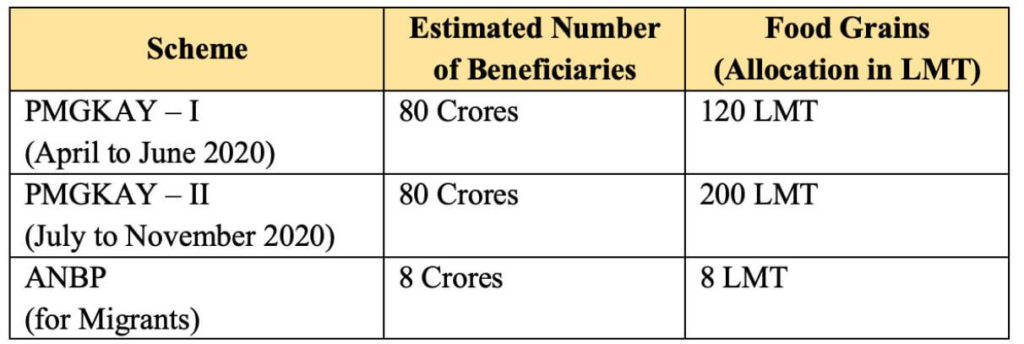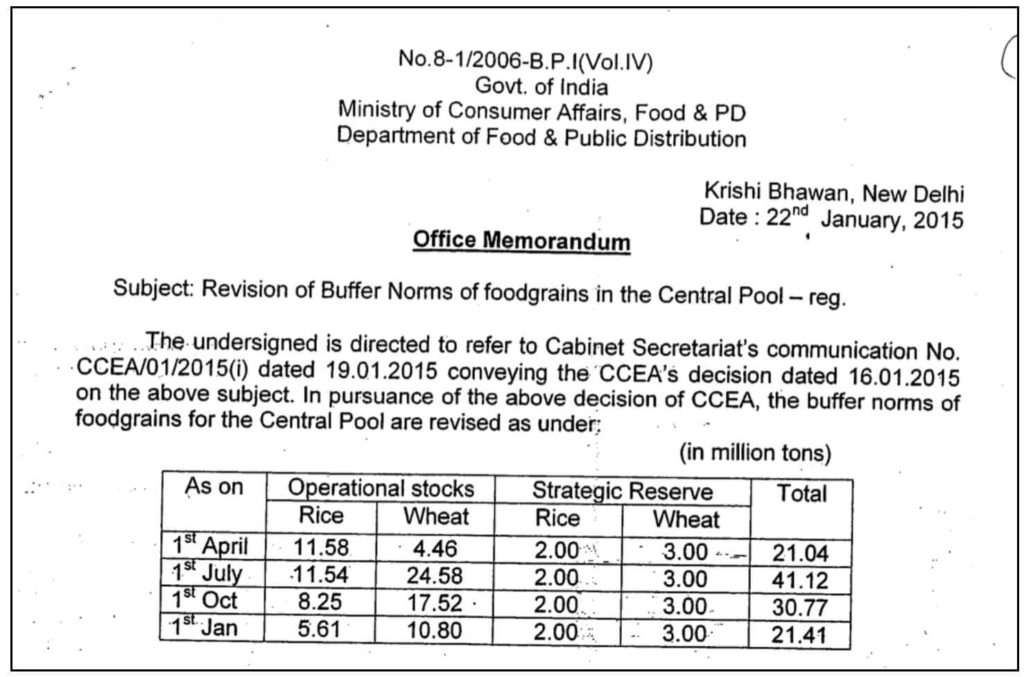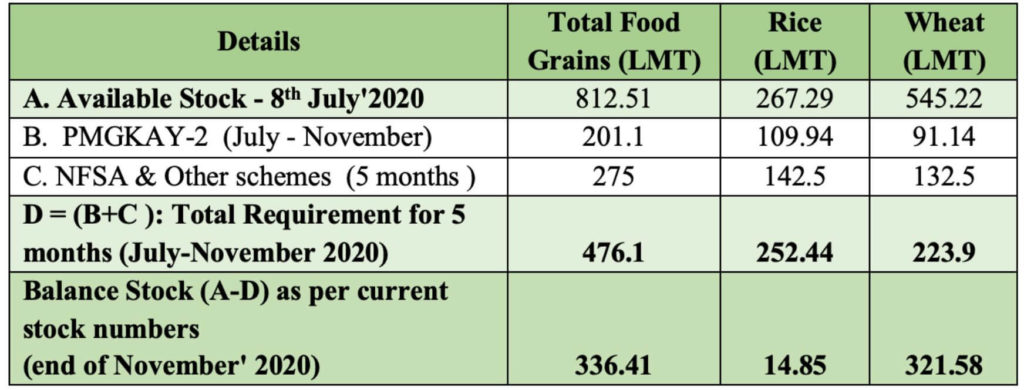The Government announced multiple food security related schemes to help people tide over the COVID-19 induced crisis. However, even accounting for the additional requirement, data indicates that the buffer stock levels with FCI are way beyond the requirement and this might only increase the storage & other associated costs.
On 16 May 2020, Government of India announced distribution of food grains free of cost at 5 kg per month in a family under the Atma Nirbhar Bharat Package (ANBP), to nearly about 8 crore migrant labour who are not covered under NFSA or State PDS (Public Distribution System) schemes.
This announcement was made to extend support for migrant families whose livelihood has been affected due to nationwide lockdown and its aftermath on account of COVID-19. Under this scheme, the food grains would be provided for the months of May & June of 2020. The government estimates the allocation of food grains under this scheme to be the tune of 8 Lakh Metric Tonnes (LMT).

Prior to this, an additional 5 kg of food grains per month was announced to be provided to those under NFSA and to priority households under Antodaya Anna Yojana under Pradhan Mantri Garib Kalyan Ann Yojana (PMGKAY) as part of COVID-19 relief measures. The initial provision was for 3 months (April-June’20) and the number of beneficiaries was pegged at 80 crores. On 30 June 2020, the Prime Minister announced extension of this scheme for another 5 months i.e. until November 2020.

The total allocation for PMGKAY was 320 LMT (120 LMT for April-June’2020 and 200 LMT July-November’20). Hence the additional food grains which the Government has proposed to distribute under these two schemes is around 328 LMT.

Similar to the distribution of food grains under PDS and various other schemes, these additional food grains would also be distributed from the stocks available with Food Corporation of India.
However, does FCI have stocks to cater to this additional requirement?
Current available stock is higher than the buffer requirement specified by government
The Government of India determines the food grain stocking norms i.e. the level of stock to be kept in the Central pool. This stock is used to meet the operational stock requirement and for any exigencies. Operational Stocks refer to the food grains needed for monthly distribution under TPDS (Targeted PDS) & Other Welfare Schemes (OWS). The latest stocking norms are as per an order dated January 2015. The stocking norms are for specified for the beginning of every quarter and consist of operational stocks and strategic reserves.

As per the information provided by FCI, the available stock of rice as on 28 June 2020, is 266.29 LMT. This is higher than the 135.4 LMT buffer stock to be maintained by 01 July 2020.
Similarly, the available stock of wheat with FCI as on 28 June 2020 is 550.31 LMT, which is nearly double the 275.8 LMT limit of wheat that needs to be maintained by 01 July 2020 as per buffer stock norms.
Increasing trend in the availability of Rice buffer stock in FCI Central Pool
In addition to the maintenance of stocks beyond the required buffer limit, an increasing trend in the stock position is also observed over the years. In an earlier story, we analysed the trend of increase in the procurement of Rice and Wheat year on year, especially the record procurement in the current year.
Analysis of the stock information of FCI shows an yearly increasing trend, when the quarter stock positions are compared. In 2016, the buffer stock of rice available on 01 January was 126.89 LMT, which increased to 134.75 LMT in the following year 2017. An increase is also recorded both in 2018 & 2019. As on 01 January 2020, the buffer stock of rice available was 237.15 LMT.
Similar trend is observed in the stocks available on 01 April every year. In 2016, 221.61 LMT buffer stock of rice was available which increased every subsequent year. A total of 322.39 LMT of rice was available with FCI in central pool as on 01 April 2020.
In 2016, 194.14 LMT of rice was available on 01 July 2016. The availability of stocks during this period has also increased in the subsequent years. On 01 July 2019, a total of 284. 21 LMT of rice was available. Bucking the trend, the stock available in 2020 during this period (as on 28 June) was lower than previous year at 266.29 LMT. However, it has to be noted that additional rice was distributed during April-June period in line with the support package announced due to lockdown. Furthermore, substantial amount of stock is in transit and is yet to be stocked in FCI Godowns, which could increase the available rice stock.
The availability of rice stocks as on 01 October also followed a similar increasing trend over the years like the other quarters. It remains to be seen if the trend continues in 2020, especially after the increased grain distribution as part of various relief packages in the wake of COVID-19.
It is to be noted that apart from this stock of rice, there is also stock of un-milled paddy available with FCI, which also shows an increasing trend in the available stocks during different quarters every year.
Increasing trend in Wheat buffer stock over the past three years
Barring the first two quarters in 2017, the buffer stocks of wheat have registered a corresponding year on year increase for every quarter. The increase in the stocks for 2020 has been especially more significant.
On 01 January 2016, the stock of wheat with FCI was 237.88 LMT which fell in next year. The stocks have since registered an increase every subsequent year. Similar trend is observed at the beginning of next quarter i.e. 01 April. There is a significant increase in the buffer stock on 01 April 2020, with nearly 77 LMT more than last year. The stock of wheat as updated on 28 June 2020 was also higher than last year by 98 LMT.
Current Stocks are enough to meet the increased requirement
As per a press release by Ministry Consumer Affairs, Food and Public Distribution, the total Food grain stock available as on 08 July 2020 ( according to FCI report ) is 812.51 LMT. Of this, Rice Stocks amount to 267.29 LMT and the stocks of Wheat are to the tune of 545.22 LMT.
In the same press note, it is stated that out of the 120 LMT allocated to the states as part of the first instalment of PMGKAY (April – June’2020), 116.02 LMT have already been lifted by the states. This leaves around 4 LMT which is yet to be lifted out of the allocated stock of food grains for those three months.

The second installment of PMGKAY, for the five months of July-November’2020 has an allocation of 201.1 LMT. This includes 109.94 LMT of rice and 91.14 LMT of wheat to be provided to various states and UTs.
Government estimates that nearly 55 LMT of food grains are required per month to meet the demands under NFSA and other schemes. This is corroborated by the Allotment and Offtake numbers provided by FCI. As per the actual figures of 2018-19, the average monthly off take of rice was approximately 28.5 LMT while that of wheat is around 26.5 LMT.
Therefore, the Government would be requiring a total of around 275 LMT of food grains (142.5 – Rice & 132.5 – Wheat) to meet the requirement for NFSA and other schemes for the five-month period of July- November’20.
Therefore, the total Food grains needed to meet the requirement under PMGKAY – II and NFSA & Other schemes for the five-month period (July-November’20) is 478.1 LMT. This leaves a balance of 336.41 LMT from the current available food grains stock by the end of November’2020. Of this, the balance of rice from the current stock is 14.85 LMT and wheat it is 321.58 LMT.

This calculation is based on the current available stock. However, the following has to be noted in calculating the balance stock numbers.
- Procurement is still in progress. The season for Rice ends in September although most of the procurement does happen by July, as per trends of previous years. Even for Wheat, most of the procurement happens during this period. Some of the procured stock is yet to reach the godown, which could further increase in the available stock.
- As per FCI data, 208.95 LMT of un-milled paddy is still with various millers. This would further increase the available rice stocks once they reach the FCI after milling.
- The next procurement season for paddy starts around October. Even after accounting for the impact of lockdown, the paddy from the Kharif season would significantly add to the rice stocks. Trends of previous years indicate increase in stocks of un-milled paddy from the month of October.
In an update on ANBA for migrant workers, the government mentioned that the states have already lifted 6.39 LMT of the allocated 8 LMT for this scheme. With many migrants reaching their native places, it estimated that their food security needs would be met through NFSA and PMGKAY – II.
Therefore, there would be no major impact on the current available buffer stocks through this scheme, even though the government has extended the date until 31 August for the sates to distribute the food grains.

Therefore, despite the additional burden of various schemes announced to provide food security during the current turbulent times, enough food stocks are available to meet this additional demand if one goes by the numbers. Furthermore, these stocks would be replenished by end of November’2020 to meet the regular monthly demand of NFSA & other schemes from December’2020 and also maintain the required buffer stocks to earlier levels or even more.
Increasing Buffer stock levels are a cause of concern for FCI
As the data indicates, the current buffer stock levels are substantially higher than the specified norms. Even taking into consideration any exigency or a pandemic situation like COVID-19, the stocks are projected to continue with the increasing trend as observed over the years. There are multiple issues with holding buffer stock beyond the requirement. Some of them are;
- One of the major concerns around maintaining buffer stocks is the cost incurred in storage. Currently, the FCI pays ₹ 5.21 per bag of 50 kg per month to the Central Warehousing Corporation (CWC) for a guaranteed one-year storage. As per the FCI’s 2017-18 annual report, the organization spent close to ₹ 7000 crores in carrying cost (storage) of buffer stocks. With increasing buffer stocks, the storage cost is only going to increase. Every additional LMT of buffer stock is going to cost upwards of ₹ 250 crores annually for storage.
- The debt of FCI has already tripled between 2014-19. Responding to a question in Lok Sabha on 19 November 2019, the government stated that FCI has a debt of ₹ 2.53 lakh crores as 31 March 2019. Out of it, ₹ 1.9 lakh crores are due to the borrowings from National Small Savings Fund (NSSF), which was arranged by the government in lieu of the dues that it has to pay to FCI.
- Apart from the cost of storage, another issue is with food grains getting rotten, though the quantum of rotten food grains has decreased considerably over the years. Responding to another question on 17 March 2020, the Government has stated that 5.2 thousand MT of food grains were damaged in 2018-19. Over the five-year period 2014-19, a total of 38.49 thousand MT of food grains worth ₹ 48.42 crores were damaged.
- Sale through Open Market Sale Scheme (OMSS) is an option available to dispose the buffer stocks. However, the volume of stock sold in the open market is very less. A total of 16.11 LMT of Rice was sold through OMSS in 2019-20. As for Wheat, 36.35 LMT was sold during 2019-20.
There are also concerns around FCI not being able to ensure Price security to the farmers. With increased procurement, FCI may also be limiting lucrative options for farmers that an open market may offer.
The National Policy on Biofuels – 2018 allows for conversion of surplus quantities of food grains to ethanol, based on the approval of National Biofuel Coordination Committee. In line with this policy, the committee recently approved that the surplus rice available with Food Corporation of India (FCI) may be converted to ethanol for utilization in making alcohol-based hand-sanitizers. However, it is still unclear as to how much of the excess food grains will be approved for this purpose. Hence, the effectiveness of this policy is not yet known. Furthermore, various groups have opposed this policy in the light of uncertain times following COVID-19.
As FCI is not able to dispose the excess stock it has procured, there are questions around the prudence of government’s procurement policy. There is a need for FCI to identify effective ways of disposing the stock, to ensure it continues with its goal of providing price security to farmers as well as ensuring food security.
Featured Image: Food security schemes


